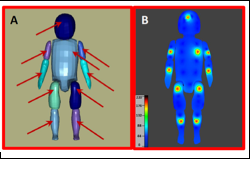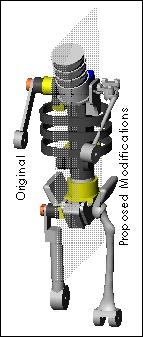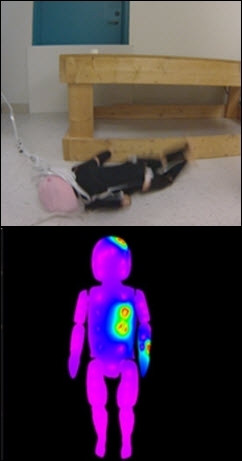Pediatric Accidental & Abusive Injury
Development of a Computer Simulation Model to Describe Potential Bruising Patterns Associated with Common Childhood Falls
funded by the Office of Investigative and Forensic Sciences, National Institute of Justice, Grant No. 2014-DN-BX-K006
C
Biomechanical Assessment of Femur Fracture in Pediatric Falls
funded by the Eunice Kennedy Shriver National Institute of Child Health and Human Development (NICHD Grant No. 1R03HD078491-01).
Child abuse is the leading cause of trauma-related fatalities in children less than four years of age. Children aged one year or less are particularly at risk with approximately 1 out of every 48 children in this age group suffering from abuse. Cases of physical child abuse are commonly mistaken for accidental trauma. This often leads to repeated, escalating injuries to the child. If an abused child is returned to an unsafe home environment, there is up to an 80% risk for additional injury and up to 30% risk of death. Fractures are early indicators of child abuse, appearing in up to 55% of child abuse cases. However, fractures are also a common result of accidental trauma, such as household falls. Clinicians are often faced with the task of determining whether a child’s injuries are the result of accidental causes or whether abusive mechanisms should be suspected. This may be difficult given that fractures are a common occurrence in both abusive and accidental cases. Since household falls are a common false history given by caretakers to cover up abusive trauma, specific information regarding fracture potential in short-distance falls may aid clinicians in distinguishing abusive from accidental injuries, thus improving the accuracy of child abuse diagnoses.
The purpose of this study is to provide objective, biomechanically-based information about femur fracture potential in short-distance falls. Three specific aims have been established to address this goal:
- Determine femur loads (type and magnitude) associated with short-distance falls in young children.
- Describe the likelihood of femur fracture in short-distance falls.
- Develop an improved understanding of the influence of child-specific bone characteristics on fracture potential.
This study will in volve two primary methodological components. In the first, fall simulations will be conducted using a child surrogate to determine femur loading characteristics. A CRABI 12-month-old anthropomorphic test device (ATD) will be modified for improved biofidelity and instrumented to measure femur loads directly. The second component involves development of a finite element model of a 12-month-old child’s femur that will extend beyond the ATD experiments by providing insight into where and what type of fractures could result from the combined loading scenarios seen experimentally. Additionally, since limited data exists regarding pediatric femur mechanical properties, key parameters will be varied in the model as part of a sensitivity analysis to determine their effect on fracture potential. This will elucidate the effect of child-specific characteristics such as bone density and geometry on femur fracture potential. The outcomes from this study will provide an improved understanding of femur fracture potential in short-distance pediatric falls allowing for better assessments of compatibility between a child’s injury and the provided history.
volve two primary methodological components. In the first, fall simulations will be conducted using a child surrogate to determine femur loading characteristics. A CRABI 12-month-old anthropomorphic test device (ATD) will be modified for improved biofidelity and instrumented to measure femur loads directly. The second component involves development of a finite element model of a 12-month-old child’s femur that will extend beyond the ATD experiments by providing insight into where and what type of fractures could result from the combined loading scenarios seen experimentally. Additionally, since limited data exists regarding pediatric femur mechanical properties, key parameters will be varied in the model as part of a sensitivity analysis to determine their effect on fracture potential. This will elucidate the effect of child-specific characteristics such as bone density and geometry on femur fracture potential. The outcomes from this study will provide an improved understanding of femur fracture potential in short-distance pediatric falls allowing for better assessments of compatibility between a child’s injury and the provided history.
Development of a Device to Describe Bruising Patterns Associated with Common Childhood Falls
funded by the US Department of Justice, National Institute of Justice (Award No. #2008-DD-BX-K311). The opinions, findings, and conclusions or recommendations expressed in this overview are those of the PI and do not necessarily reflect those of the Department of Justice. US Patent No 8292830 B2
Child abuse is a leading cause of fatality in children 0-4 years of age. Roughly 1500 children fatally injured each year in association with child abuse and 150,000 are permanently disabled. Many of the serious injuries and fatalities could have been prevented if clinicians and child protective services were able to better distinguish between those injuries associated with abuse and those injuries caused by accidents. Clinicians, and child protective services and law enforcement personnel must therefore be equipped with improved knowledge related to the types of injuries that are possible from common household accidents that are often reported to be the underlying cause of injury in child abuse. The ability to detect child abuse at the earliest stages has proven to be critical in the prevention of escalating injury severity and even death. Bruising is an early sign of abuse, and has proven to be an effective indicator and sentinel of child abuse. Moreover, bruising patterns provide a “roadmap” documenting a child’s exposure to impact; information that can be critical in a forensic biomechanical analysis of the child’s injuries.
 Our multidisciplinary Injury Risk Assessment and Prevention Laboratory is utilizing state of the art bioengineering techniques to aid clinicians and legal services personnel in distinguishing between abusive and non-abusive injuries. One component of our research relies upon the use of instrumented anthropomorphic test devices, or test dummies, to investigate injury risk in common childhood falls and accidents. We have effectively used these test dummies to investigate head injury and bone fracture risk in children. However, the ability to predict bruising patterns occurring in association with falsely reported events in child abuse does not exist, but could prove extremely useful in the distinction between abusive and accidental injuries in the clinical and medico-legal settings. ***Our study proposes to modify an existing pediatric test dummy to allow for the prediction of potential bruising location, size and patterns in children during common household fall events that are often stated as false scenarios in child abuse. The scope of this project will include the development of a “sensor skin” that will be adapted to a commercial pediatric test dummy. When used in mock laboratory experiments representing common household injury events, the “sensor skin” adapted test dummy will measure and record levels of impact force and locations of impact encountered by the human surrogate. Data from the sensors will be acquired and compiled in a computerized visual body map image displaying the areas of contact or impact that represent potential bruising or soft tissue injury. This body map image will then provide a “roadmap” of the human surrogate’s exposure during a specific event and will define a compatible bruising roadmap-specific event combination. A database of bruising roadmap-event combinations will ultimately be developed for various common household falls. The “bruising roadmaps” will be available as a tool in suspected child abuse cases where bruising exists as an aid in determining whether presenting soft tissue injuries are compatible with the stated cause.
Our multidisciplinary Injury Risk Assessment and Prevention Laboratory is utilizing state of the art bioengineering techniques to aid clinicians and legal services personnel in distinguishing between abusive and non-abusive injuries. One component of our research relies upon the use of instrumented anthropomorphic test devices, or test dummies, to investigate injury risk in common childhood falls and accidents. We have effectively used these test dummies to investigate head injury and bone fracture risk in children. However, the ability to predict bruising patterns occurring in association with falsely reported events in child abuse does not exist, but could prove extremely useful in the distinction between abusive and accidental injuries in the clinical and medico-legal settings. ***Our study proposes to modify an existing pediatric test dummy to allow for the prediction of potential bruising location, size and patterns in children during common household fall events that are often stated as false scenarios in child abuse. The scope of this project will include the development of a “sensor skin” that will be adapted to a commercial pediatric test dummy. When used in mock laboratory experiments representing common household injury events, the “sensor skin” adapted test dummy will measure and record levels of impact force and locations of impact encountered by the human surrogate. Data from the sensors will be acquired and compiled in a computerized visual body map image displaying the areas of contact or impact that represent potential bruising or soft tissue injury. This body map image will then provide a “roadmap” of the human surrogate’s exposure during a specific event and will define a compatible bruising roadmap-specific event combination. A database of bruising roadmap-event combinations will ultimately be developed for various common household falls. The “bruising roadmaps” will be available as a tool in suspected child abuse cases where bruising exists as an aid in determining whether presenting soft tissue injuries are compatible with the stated cause.
Biomechanics and Injury Assessment of Household Falls in Children
funded by the University of Louisville Grosscurth Biomechanics Endowment Fund and US Department of Justice, Office of Juvenile Justice and Delinquency Prevention (Award #2009-DD-BX-0086). The opinions, findings, and conclusions or recommendations expressed in this overview are those of the PI and do not necessarily reflect those of the Department of Justice.
Child abuse is the leading cause of trauma-related fatalities in children less than four years of age. Children aged one year or less are particularly at risk with approximately one out of every 41 children in this age group suffering from abuse. Pediatric short distance falls, especially from beds or other furniture, are a common false history given by caretakers to cover up abusive trauma. In up to 70% of cases of children with abusive injuries, the initial explanation for the injuries given by the caretakers is a fall. However, short distance household falls are also a common occurrence in young children. Knowledge of the types and severity of injuries that can result from these short falls is necessary since clinicians are commonly asked to determine whether a child’s injuries are consistent with the stated cause of the injuries, when attempting to distinguish between inflicted and non-inflicted injuries. Early detection of abuse may lead to prevention of further escalating injuries and, in some cases, prevent the death of the child.
The purpose of this study is to provide objective information about injury risk in short distance falls to aid clinicians in distinguishing between inflicted and non-inflicted injuries in children. This will be accomplished by investigating the injury outcomes and biomechanics associated with common household falls. The specific aims of this study are to determine injury types and severities that are associated with short distance falls from horizontal furniture surfaces (such as a fall from bed, crib, couch, or table) in children ages 0-4, describe fall dynamics and determine biomechanical measures associated with these falls, describe relationships between biomechanical measures and injury outcomes, and to determine whether fall environment factors (height of fall, impact surface), initial position, initial velocity and surrogate characteristics affect the injury outcomes.
This study involves three major methodological components to address the specific aims and obtain a better understanding of injury risk in short distance household falls. The first component is a case-based biomechanical assessment of children who present to the emergency department of a metropolitan children’s hospital with a history of a fall from a bed or other similar furniture. Descriptions of fall dynamics and the fall environment will be obtained through interviews with the caregivers and in-depth scene investigations. The second component utilizes an anthropomorphic test device (ATD), or human surrogate, representing a 12-month-old child, to experimentally simulate falls from furniture surfaces in a laboratory setting. The final component involves development of a validated computer model based upon the ATD experiments. The computer model will extend beyond the experiments by allowing variation in fall parameters and ATD characteristics. In each component, relationships between biomechanical measures and injury outcomes will be investigated.
Click below to see videos of fall experiments and computer simulations.
Development of a Classic Metaphyseal Lesion (CML) Biomechanical Model
funded by the US Department of Justice, Office of Juvenile Justice and Delinquency Prevention (Award #2009-DD-BX-0086). The opinions, findings, and conclusions or recommendations expressed in this overview are those of the PI and do not necessarily reflect those of the Department of Justice. Also funded by the Whitaker Foundation
Fractures are the second most common injury resulting from child abuse and are often indicative of escalating violence. The Classic Metaphyseal Lesion (CML), also known as the corner, or bucket-handle fracture, is reported to be highly associated with abusive trauma, although the pathophysiology and biomechanics associated with this fracture type are currently unknown. When a young child or infant presents with a fracture, a determination must be made: how much force did it take to cause this injury and could the scenario provided generate the level of force needed to cause the fracture? Is normal bone present or are there factors that might alter fracture threshold? An inaccurate assessment can result in an abused child being placed back into an unsafe environment, where there is an 80% chance of re-injury and a 10-50% chance of mortality. Conversely, innocent families may be investigated for child abuse and non-abused children may be placed into foster care. Differentiating between accidental and abusive fractures however can be extremely difficult. A current lack of biomechanical understanding of fractures in immature bone and the lack of an objective tool for evaluating bone strength and likelihood of fracture in children makes this determine more difficult.

The goal of this project is to identify loading conditions necessary to create a CML. In order to accomplish this, multiple methodologies will be utilized:
1) Mechanical testing of porcine hind-limb specimens under various loading conditions in an attempt to produce a CML type fracture. All testing will be conducted under the protocol approved by the University of Louisville Institutional Animal Care and Use Committee (IACUC protocol #10154).
2) Finite element analysis to create a virtual bone model that can be used to further investigate the bone's response to loading and fracture development.
3) Development of a synthetic bone surrogate that can replace animal specimens in investigation of pediatric fractures.
